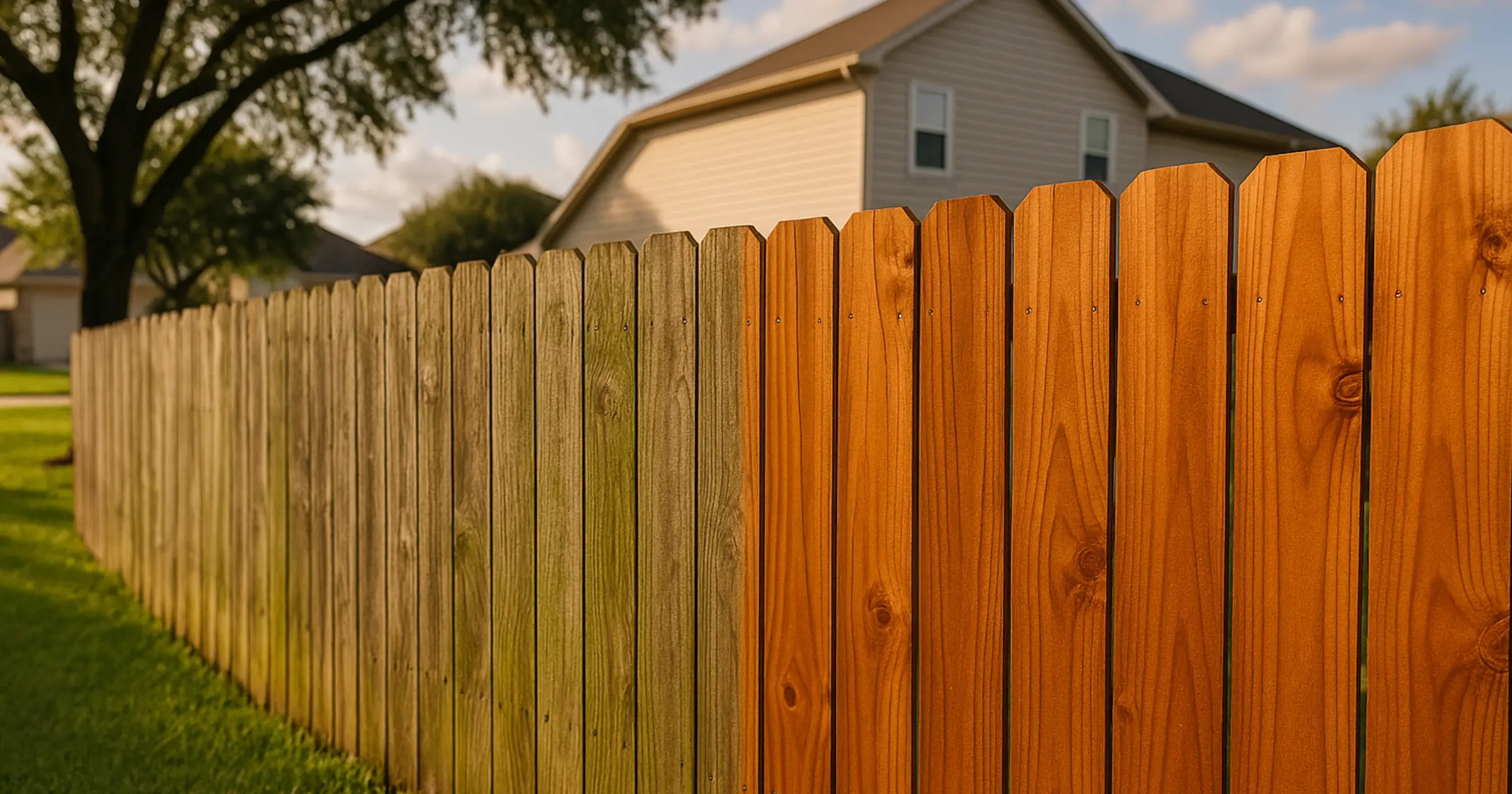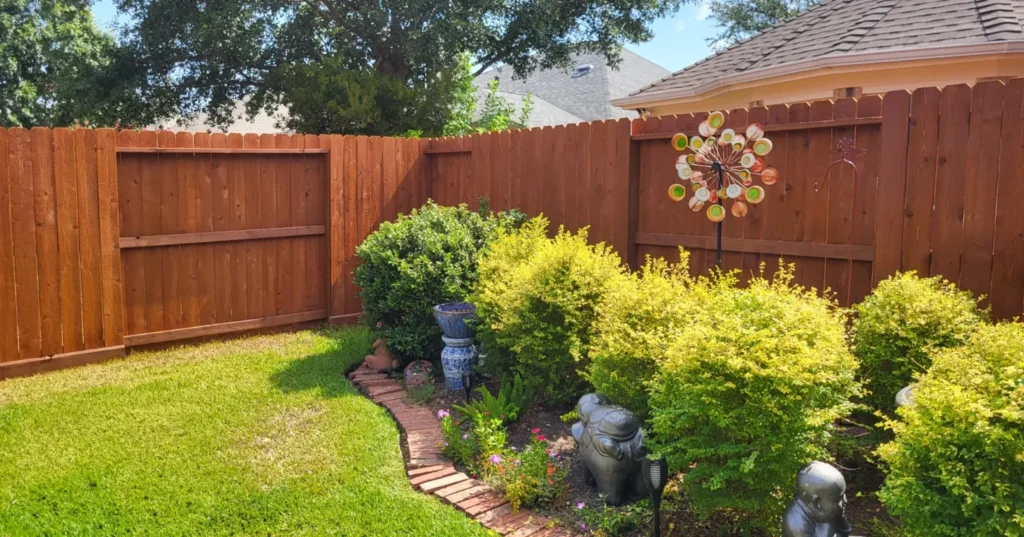
If your fence looks like it’s trying to become part of your lawn, you’re not alone. Learning how to remove green algae from fence surfaces is one of the most common challenges Houston homeowners face. That green film isn’t just ugly, it’s slowly eating away at your wood. Here’s the good news: catching algae early means a $200 cleaning instead of a $2,000 replacement.
Last spring, half of Towne Lake had fences covered in green algae. The HOA was sending notices left and right. Sarah Martinez called me in a panic: “My fence looked fine last month, now it’s green! My HOA meeting is next week.” We showed her exactly how to remove green algae from fence boards before permanent damage set in, saving both her fence and her wallet. Here’s what every Houston homeowner needs to know.
What Is Green Algae on Fences?
Green algae on fence surfaces appears as a thin, slippery film that thrives in Houston’s humid conditions. Unlike mold, algae needs sunlight to grow, which is why you’ll see it on fence surfaces that get morning sun but stay damp from shade in the afternoon.
You know that green film that shows up every spring? It’s not random. Algae spores are always in the air, just waiting for the right conditions. In Houston, we give them exactly what they want:
- Morning dew that doesn’t dry until noon
- 75% humidity most days
- Those afternoon thunderstorms
- Just enough sun to feed growth
Here’s what I tell my neighbors in The Woodlands: if your fence feels slimy after rain, that’s active algae. If it’s powdery when dry, it’s been there a while. Either way, it’s breaking down your wood’s protective surface. Understanding how to remove green algae from fence properly starts with identifying it correctly.
Why Your Fence Turns Green After Rain in Houston
Your fence turns green after rain because water activates dormant algae spores already on the wood. The rain provides the moisture algae needs to bloom, while Houston’s warm temperatures create perfect growing conditions. North-facing fences and areas under trees are especially vulnerable since they stay damp longer.
Remember when your fence was actually brown? That was before our Houston weather pattern kicked in. Here’s what’s happening:
The Morning Problem: Dew forms on your fence around 5 AM. By the time the sun hits it at 9 AM, algae has had four hours of moisture to grow.
The Shade Trap: That big oak tree keeping your house cool? It’s also keeping your fence damp. Algae loves these partially shaded spots, the exact areas where you need to know how to remove green algae from fence sections effectively.
The Rain Cycle: Every afternoon shower reactivates the algae. It’s like watering a garden you don’t want.
A homeowner in Cypress asked me last week, “Why is only half my fence green?” Simple, the sunny side dries fast enough to prevent growth. The shaded side stays damp all day, which is why learning how to remove green algae from fence in these problem areas is critical.
Can You Remove Green Algae From Fence Yourself?
Yes, you can remove green algae from fence surfaces yourself, but success depends on using the right method and products. Many DIY attempts fail because homeowners use pressure washers at full strength (which damages wood fibers) or bleach alone (which doesn’t prevent regrowth). The key is killing the algae roots, not just cleaning the surface.
If you’re determined to try DIY, here’s what actually works versus what makes things worse:
Common Mistakes:
- Pressure washing at full strength (strips wood fibers)
- Straight bleach (kills plants, doesn’t last)
- Scrubbing with wire brushes (gouges wood)
- Ignoring it until next year (deep damage)
That slippery feeling when you touch it after rain? That’s active growth. Once algae penetrates the wood grain, surface cleaning won’t cut it. You need to understand how to remove green algae from fence wood at the root level.
How to Remove Green Algae From Fence: The 3-Step Expert Process
Step 1: Identify and Prepare (Don’t Skip This!)
Before learning how to remove green algae from fence effectively, make sure it’s actually algae. Green algae on wood fences looks like a thin, even coating. It’s slippery when wet, powdery when dry. If it’s fuzzy or thick, that’s moss or mold, different problem, different solution.
Prep your area:
- Cover plants with plastic sheeting
- Move patio furniture back 6 feet
- Warn your neighbors (they’ll thank you)
- Pick a dry day with no rain for 48 hours
- Gather materials: oxygen bleach, soft brush, garden hose, dish soap
This preparation step is crucial when you’re learning how to remove green algae from fence surfaces without causing collateral damage to your landscaping.
Step 2: Apply the Right Cleaning Solution
Here’s exactly how to remove green algae from fence wood using a professional-grade approach:
Mix this solution:
- 1 part oxygen bleach (not chlorine)
- 3 parts water
- 1 tablespoon dish soap per gallon
Application process:
- Wet the fence with plain water first
- Apply solution from bottom up (prevents streaking)
- Let it sit for 15 minutes (keep it wet)
- Scrub gently with a soft brush in the direction of wood grain
- Rinse thoroughly with garden hose on low pressure
Sometimes it takes a second round. That’s normal for fences that have been green for months. The key to how to remove green algae from fence successfully is patience, rushing the process means the algae comes back in weeks, not years.
Professional Tip: For stubborn algae that won’t budge with oxygen bleach, we use commercial-grade algaecides that penetrate deeper into wood pores. These aren’t available at Home Depot, but they’re the real answer for how to remove green algae from fence when DIY methods fail.
Step 3: Prevent Green Algae From Returning to Your Fence
Knowing how to remove green algae from fence is only half the battle. Cleaning without prevention means you’ll see green again in 6 weeks. Here’s what actually keeps algae away:
Immediate prevention steps:
- Let fence dry completely (2-3 sunny days)
- Apply a water-repellent sealer with algae inhibitors
- Trim back vegetation for better airflow
- Redirect sprinklers away from fence
- Clear debris from fence base regularly
Long-term protection: Once you know how to remove green algae from fence properly, the next step is professional fence staining with built-in algae inhibitors. This creates a barrier that lasts 3-5 years instead of 6 weeks.
The truth? Prevention only works if you catch algae early. Once it’s been there a full season, it’s deep in the wood, and knowing how to remove green algae from fence at this stage often means calling professionals.
When to Call Professional Fence Cleaners for Algae Removal
Professional help is needed when algae covers more than 30% of your fence, returns within weeks of DIY cleaning, or has been present for over 6 months. At this point, the algae has penetrated deep into the wood fibers, and standard methods for how to remove green algae from fence won’t provide lasting results.
You need expert help when:
- Wood feels soft or punky when pressed
- Green staining goes through to the other side
- You’ve tried DIY methods 2-3 times without success
- HOA deadline is approaching fast
- Multiple fence sections are affected simultaneously
Last month, Mike from Spring tried to remove green algae from fence boards three times. Each time, the algae came back faster. Why? Surface cleaning doesn’t kill roots that go deep into wood pores. By the time he called us, he’d spent $200 on products and two weekends of work.
For comprehensive professional fence cleaning services that guarantee results, experienced contractors use methods DIYers simply can’t access.
Why Professional Algae Treatment Lasts 3-5 Years
Professional fence cleaning for algae uses commercial-grade algaecides that penetrate wood deeply and create a protective barrier. We apply products homeowners can’t buy at retail stores, solutions that kill algae roots and prevent regrowth for years, not weeks. This is how to remove green algae from fence permanently, not temporarily.
Our professional process:
- Deep penetrating algaecide (not available retail)
- Controlled application (no plant damage)
- Wood brightener (restores natural color)
- Professional-grade sealant (3-5 year protection minimum)
The biggest difference? We guarantee our work. If algae returns within our warranty period, we come back free. Try getting that from a DIY product.
When homeowners in Cypress ask us how to remove green algae from fence for good, we explain that true prevention requires professional-grade products combined with proper application techniques that take years to master.
The Real Cost of Ignoring Green Algae on Your Fence
Algae loves Houston weather, all that humidity is like a buffet. But here’s what homeowners don’t realize: algae holds moisture against your wood 24/7. That constant dampness leads to:
- Wood rot (starts in 12-18 months)
- Fence post failure ($150-200 per post to replace)
- Complete fence replacement ($25-40 per foot)
- HOA fines ($100-500 per violation)
- Decreased property value
One customer in The Woodlands ignored green algae for two years instead of learning how to remove green algae from fence early. Result? Three fence sections collapsed during a minor storm. The repair cost more than treating the entire fence would have.
Cost comparison:
- DIY algae removal: $30-75 in supplies
- Professional cleaning: $200-500 (depending on fence size)
- Replacing rotted fence sections: $2,000-5,000
- Complete fence replacement: $3,000-8,000
Understanding how to remove green algae from fence isn’t just about aesthetics, it’s about protecting a major investment in your property.
Protecting Your Houston Fence Investment

Your fence is a major investment, typically $3,000 to $8,000 for an average Houston yard. Letting algae destroy it is like never changing your car’s oil. A little maintenance saves massive replacement costs.
What works long-term:
- Professional cleaning every 2-3 years
- Quality staining with algae inhibitors
- Proper drainage around fence lines
- Regular inspections after rainy seasons
- Knowing how to remove green algae from fence at first sign
For deck staining projects, the same algae prevention principles apply, moisture control and protective sealants are essential in Houston’s climate.
Frequently Asked Questions About How to Remove Green Algae From Fence
Q: How long does it take to remove green algae from a fence?
A: DIY removal typically takes 3-4 hours for an average-sized fence (100 linear feet), including prep and cleanup. Professional removal takes 1-2 hours with better results. The key to how to remove green algae from fence quickly is having the right equipment and products.
Q: Will vinegar remove green algae from fence?
A: White vinegar (1 part vinegar to 2 parts water) works for light algae growth but isn’t strong enough for established infestations. For severe cases, learning how to remove green algae from fence requires oxygen bleach or commercial algaecides.
Q: How much does it cost to remove green algae from fence professionally in Houston?
A: Professional algae removal in Houston typically costs $200-500 depending on fence size and algae severity. This is far less than the $2,000-5,000 cost of replacing rotted sections if algae is ignored.
Q: Can pressure washing remove green algae from fence?
A: Pressure washing can remove surface algae but often damages wood fibers if done incorrectly. The proper way how to remove green algae from fence is with low-pressure application of algaecide followed by gentle scrubbing, not high-pressure blasting.
Q: How often should I remove green algae from my fence in Houston?
A: In Houston’s humid climate, inspect fences every 3-4 months. Light algae can be cleaned DIY, but professional treatment every 2-3 years with algae-resistant sealant is the best long-term strategy for how to remove green algae from fence permanently.
Q: What’s the difference between algae and mold on fences?
A: Green algae requires sunlight and appears as a thin, slippery coating. Mold is usually black or gray, fuzzy, and grows in completely shaded areas. Knowing how to remove green algae from fence is different from mold remediation, algae responds to oxygen bleach, while mold often requires fungicides.
Q: Will green algae come back after I remove it from my fence?
A: Without prevention measures, algae typically returns in 6-12 weeks in Houston’s climate. The complete answer to how to remove green algae from fence includes applying water-repellent sealers with algae inhibitors after cleaning.
Protect Your Houston Fence From Algae Today
If your fence is turning green, you have a window of opportunity. Early-stage algae (less than 6 months) responds well to treatment. Wait longer, and you’re looking at wood replacement instead of simple cleaning.
Check your fence today:
- Look for green tinting, especially on north-facing sections
- Feel for slippery or soft spots
- Check where fence meets soil (algae starts low)
- Note any areas staying damp past noon
Now that you know how to remove green algae from fence, take action before minor cleaning becomes major replacement.
For professional algae removal and prevention in Houston, Cypress, Spring, The Woodlands, and Katy, call Ninja Fence Staining at (832) 258-6164. We’ll assess your fence for free and provide honest recommendations—whether you need immediate treatment or can wait.
Don’t let that green coating fool you. It’s not just cosmetic, it’s slowly damaging your fence. The sooner you learn how to remove green algae from fence and take action, the less it costs to fix.
Get your FREE fence assessment today and protect your investment before algae causes permanent damage.
Professional fence cleaning and algae removal services provided by Ninja Fence Staining, serving Houston, Cypress, The Woodlands, Spring, Katy, and surrounding Texas communities. Specializing in algae prevention, wood restoration, and protective fence staining with 5-year warranties.

